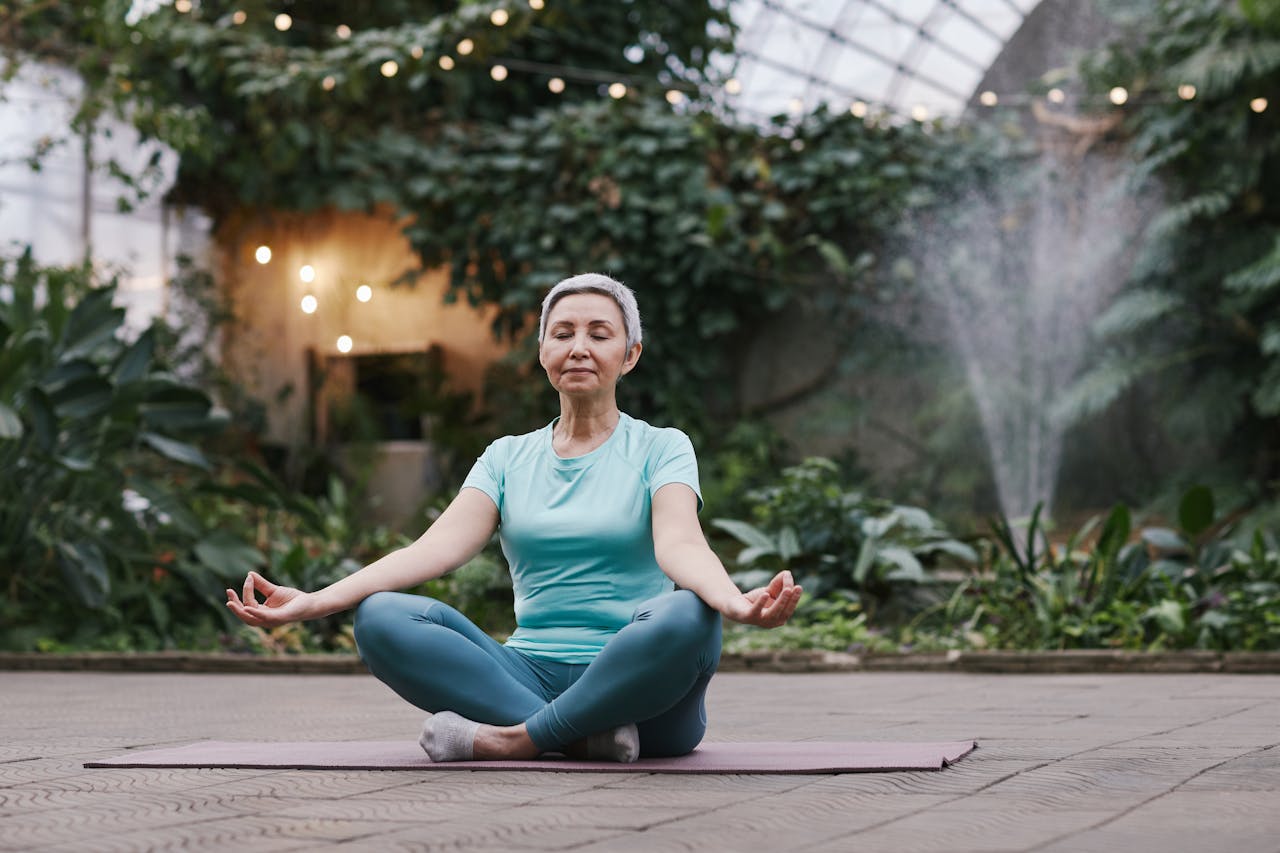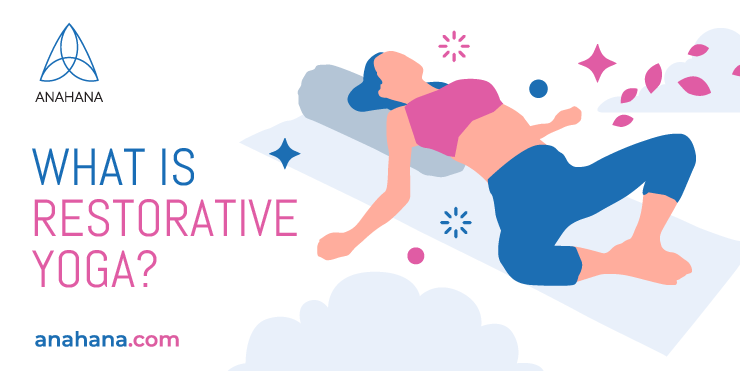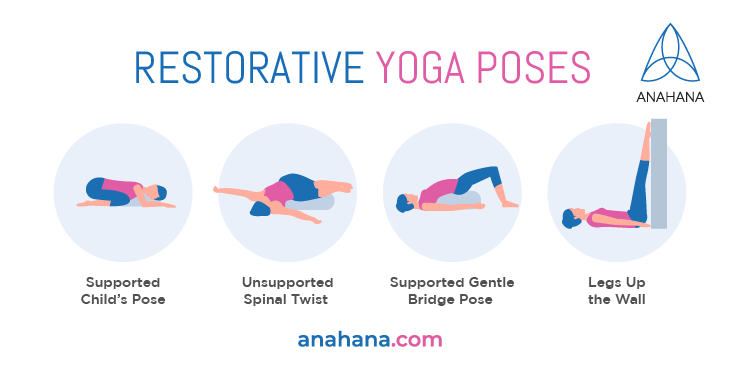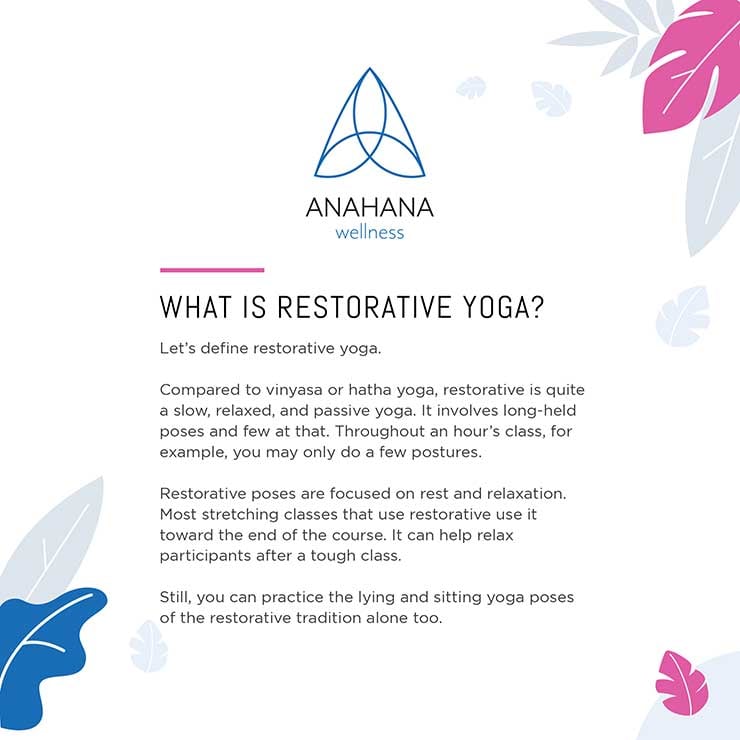
Table of Contents
Feeling stressed? If your body is aching then restorative yoga could be exactly what you need to relax and can reduce pain.
What Is Restorative Yoga?
 Restorative yoga helps you to relax mentally and physically. Compared to vinyasa or hatha yoga, restorative yoga classes have fewer poses. You hold poses for longer so that your muscles can relax. You don’t have to do anything except get your props set up for your next supported yoga pose.
Restorative yoga helps you to relax mentally and physically. Compared to vinyasa or hatha yoga, restorative yoga classes have fewer poses. You hold poses for longer so that your muscles can relax. You don’t have to do anything except get your props set up for your next supported yoga pose.
Restorative yoga classes are a great way to unwind. The restful yoga poses are also an excellent substitute if you are too tired to take a regular yoga class. In some cases, you may find that you feel recharged enough to do more active asanas after a few restorative poses. Then again, you might find that all you want to do is more restorative poses.
Attending Restorative Yoga Classes
If you are lucky, a yoga studio near you offers a restorative yoga class at a time that suits you.
You can also do restorative yoga at home, and while it is helpful to have props, you can do quite a lot of restful poses with just the use of a wall and even a couch.
The nice thing about doing restorative yoga at home is that you don’t have to walk or drive anywhere at the end of your session. You can simply stay put, enjoying the after-effects of deep rest.
Restorative yoga props
If you want to use them, some props useful for an at-home restorative yoga practice include bolsters (one or two), yoga blocks, straps, and even folded yoga blankets.
Another prop that can be very nice if you practice in the daytime (and even if not) is an eye bag. You can place an eye pillow over your eyes whenever you lie face up in a restorative pose. You may find it helps your eyes and the muscles around them to relax.
Benefits Of Restorative Yoga
Restorative yoga practice is excellent for turning on your parasympathetic nervous system, also known as the relaxation response. When this occurs, your body is no longer in a state of fight or flight. Your body can rest and digest and do all the things it can’t do if you are in a state of stress.
A restorative yoga session provides emotional relaxation and can leave you feeling refreshed and restored. It can also give you improved digestion, better sleep quality, and improved respiration (you can breathe easier.) You may also find that you have lower blood pressure, a lower heart rate and an improved immune system after a restorative class or two.
The supported poses make it very easy to relax, and you may find that you fall asleep or into a state that is just on the edge of sleep. All of this can go towards improved overall health and well-being. An additional effect is that you may have Improved concentration.
Because these restful poses let you release tension and relax, afterward, you may have a calmer, more-centered attitude with reduced stress and anxiety. Plus, you may get fewer headaches, less bodily pain and discomfort and experience faster physical healing.
Yin Yoga Isn’t Restorative Yoga
Another type of yoga focusing on relaxation is yin yoga. However, yin yoga and restorative yoga are two very different things.
In yin yoga the focus is on stretching and improving proprioception (the ability to feel your body.) It can also be mentally challenging because of the discomfort.
In restorative yoga, the intent is to support the body so that your body and your mind can relax. The intent is to be as supported and as comfortable as possible.
The deep relaxation can be so great that it is easy to fall asleep in a restorative yoga class. The same is not true with yin yoga.
Restorative Yoga Poses you can do at home

Supported Child’s Pose
For a supported child’s pose, you can use a cushion from your couch as a prop. You might also like a folded blanket to place beneath your feet.
Start in a kneeling position with a cushion laid across your legs. Bend forwards so that your head and chest rest on the pillow. Turn your head to one side. Hug the cushion with both arms.
Spend about three to five minutes with your head turned one way. Then turn your head to the other side. You can also switch your arms when turning your head.
If you have difficulty kneeling because of tight or painful knees, you may find it helpful to have an additional cushion to place between your bum and your heels. Another option is to do this pose while sitting in a chair as shown below.
Couch Supported Twist
For this restorative yoga pose, you’ll need your couch.
Kneel with hips lifted in front of your sofa and then sit down to one side of your feet. Bend forwards to place your chest and head on your couch's cushions. Pillow your head with your arms and turn your head to the same side as your feet.
For extra support, place a cushion or pillow between your thighs and the bottom of your ribcage.
Spend three to five minutes on one side and then switch.
Unsupported Spinal Twist
If you haven’t got a couch handy, then this supported twist can be done on the floor without any props at all. You might want to do it on a comfy carpet or blanket, though.
Start on all fours. Move both hands to one side so that you can sit your hips on the floor to one side of both feet. Use your arms to help lower your chest to the floor and turn your head to the same side your feet are on.
We’ll get to adjusting leg positioning in a bit, but use a comfortable position for your arms. You can try placing your bottom arm on the floor slightly behind you with the outside of the elbow against the floor. Place your upper arm on the floor in front of you with the inside of the elbow on the floor.
Because you aren’t using any props, you may have to play with leg positioning so that your lower back is comfortable. There are three basic leg options.
-
Initially, try the pose with your knees together.
-
Then try placing the top knee slightly forwards of the bottom knee and notice how it feels on your low back.
-
Finally, try straightening the top leg back, more or less in line with your spine, so that the top knee is slightly behind the bottom knee. In this position, you can then adjust the position of your top hip by moving your top foot closer to your body or away from it.
Use whichever of the above options feels most comfortable for your low back. If you can’t find a leg position that is comfortable for your low back, leave this posture out.
Spend two to three minutes in this position and then switch sides.
Supported Gentle Bridge Pose
For this pose, you will need a bolster or a cushion, say from your couch. A blanket or yoga blocks may also be handy.
To begin, sit on the floor with your cushion behind you. Lay back with your ribcage on the cushion while keeping your butt on the floor. If your cushion is short enough, position the yoga block as a support for your head. Ideally, your head is comfortably higher than your ribcage. Another option is to place a folded towel or blanket on the cushion beneath your head.
Once comfortable, you can place your hands on your chest or out to the sides.
Make sure your lower back is comfortable, and if it is, spend about three minutes resting in this position.
This is an excellent opportunity to use an eye pillow if you have one.
Legs Up the Wall
The legs-up-the-wall position, aka Viparita Karani, is one of the most basic and reliable restorative yoga poses.
You can also use it to begin a yoga session, rest, recharge, and even centering yourself before starting.
Lie on the floor with your legs to the side and your butt against the wall. From there, swing your legs up the wall. Have your feet together and knees straight.
-
If you find this position uncomfortable on your legs' backs because of tight hamstrings or your lower back is painful, move your butt away from the wall far enough so that your lower back and legs are comfortable.
-
Another option is to rest on your back, with knees bent and lower legs resting on the seat of a chair, your couch, or even a coffee table.
You can rest your hands on your chest or by your side in either case.
For a slight change in effect, try doing the pose with a yoga block (perhaps with a blanket or towel as padding) beneath your hips so that your hips are higher than your ribcage.
Restorative Yoga: Frequently Asked Questions
Is the restorative style of yoga suitable for beginners?
The slow and relaxed pace of a restorative yoga class makes it an ideal practice for beginners.
How often should you do restorative yoga?
You can do a restorative practice as often as you’d like. Many practitioners use the therapeutic style of yoga every day for at least a few minutes. Others may turn to it once or twice a week or when they need to relieve stress and anxiety.
Can you lose weight by doing restorative yoga?
Part of an effective weight loss program includes triggering the relaxation response to get out of fight or flight mode. Restorative yoga helps you do just that so that your body can rest, digest and restore.
References
Restorative Yoga: What It Is, Benefits, and Poses
Restorative Yoga Poses: Benefits and Poses for Relaxation
Can You Really Use Yoga for Weight Loss? We Asked the Experts How to Do It Properly
Disclaimer
The contents of this article are provided for informational purposes only and are not intended to substitute for professional medical advice, diagnosis, or treatment. It is always recommended to consult with a qualified healthcare provider before making any health-related changes or if you have any questions or concerns about your health. Anahana is not liable for any errors, omissions, or consequences that may occur from using the information provided.

Your body exists in the past and your mind exists in the future. In yoga, they come together in the present
― B.K.S Iyengar

By: Clint Johnson
Clint is the driving force and founder of Anahana. Clint teaches Yoga, Pilates, mindful breathing, and meditation, catering to a global community of students and teachers.